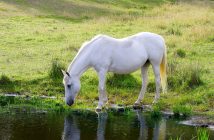A Shetland Pony is probably one of the most interesting breeds of horse there is. When children see a Shetland Pony they immediately want one. When adults see them, they want one, too, but may not admit it. Everyone loves Shetland Ponies.
The Shetland Islands of Scotland
Shetland Ponies originated in the Shetland Islands of Scotland, hence their moniker. They can exist on very little food and have been utilized as pack horses as early as 1850. England imported them, as did the United States.
It was in the United States that superior breeds of Shetland Ponies began to be produced. These new breeds are the ones we are most familiar with as children’s pets.
American Shetlands are not like the Shetland Ponies they descended from. The Shetland Ponies from Scotland were a very woolly breed, while the America Shetland Pony is more like a miniature horse. There are two types of Shetland Pony, the Classic and the Modern American Shetland.
A registered American Shetland can be no taller than 46 inches. Shetland Ponies are not measured by “hands” as other horses are. Even though the Classic is more directly related and not bred with other breeds of horse, the ones you see today are not like those Shetland Island Ponies of the 1800s.
Caring for Shetland Ponies
Grooming
Your Shetland Pony, for the most part, needs the same grooming as any other horse. They need to be washed, combed, and cared for as you would any pet. They need regular vaccinations, de-worming, and veterinary care like all horse do.
You might want to pay more attention to your Shetland Pony’s feet. They require more care. Miniature horses are a little more delicate in that area than their larger cousins. This requires daily care, so if you are thinking of getting your own Shetland Pony, please note that with it comes responsibility for their care.
Picking Hooves
Here are some tips for caring for your Shetland Pony’s feet:
Picking out your pony’s feet is one of the most important things you will do for your Shetland Pony. You may end up needing to do it several times per day for an active pony. You should check your pony’s feet before you ride, every single time. Make sure there is no debris stuck in their hooves.
The absolute best tool for this job is a hoof pick. You will definitely need to buy a hoof pick if you get a Shetland pony.
A hoof pick is a sharpened, curved tool specifically made for the task of cleaning a horse’s feet. When picking your pony’s hoof, you need to hold the pick aimed away from you (as you would do with any sharp object or tool).
You will also need a hoof brush. And it’s a really good idea to also have hoof oil. You can typically purchase a hoof pick, a hoof brush (or a combo pick/brush) along with hoof oil at your local feed store. If not, you can purchase them online or ask your Veterinarian or Farrier where you might get the tools you need to properly care for your pony’s feet.
You will need to purchase a hoof pick. It’s a sharpened curved tool especially made for this task. Always use the pick aimed away from you as you should with any sharp object or tool. You will also need a hoof brush. Later in this article I will tell you how and when each tool should be used. The other item you will need is hoof oil. You can purchase it from your local feed store most likely. If not, ask your Veterinarian.
Not checking hooves can result in serious problems for your Shetland Pony. The irritation caused by even the smallest pebble can lead to infection and injury. Think of how it feels to have a pebble in your shoe, then multiply that by ten.
After Riding
As soon as you are through riding your Shetland Pony, you need to check their feet again. And, of course, you need to cool them down after riding and brush them. The more you care for your Shetland Pony, the more they will care for you and the longer they will be around for you to enjoy.
As with any horse, your Shetland Pony should be tied up while you check their feet. Most horse groomers have a method to how they do things. You and your horse benefit from this. You benefit by having a routine that helps you remember to do everything you need to do. Your Shetland Pony benefits by knowing what to expect.
I work from front to back, taking the time to gently rub the horse’s front calf while talking to him/her soothingly. Remember, for a horse or pony, lifting their foot and standing on just three feet is not a natural act. They need to trust you. And you need them to trust you and not try to kick you away.
When you think they are ready, use a command and grip the leg firmly to lift it up. Lean your shoulder into them as you do this and they will get the message. Your horse or pony will get used to the command associated with the lifting of his/her leg and it will get easier as time goes on.
You have to be the boss that’s why your grip and determination needs to be solid. However, if your pony resists dramatically, back off and try again, soothing them with your voice as you go. They will eventually learn you are not about to hurt them.
First check to see if your pony’s hoof is hot or cold. If it feels cool to the touch, everything is fine. If you feel heat, then there is a problem. You need to contact your Veterinarian in this case. Do not groom your pony’s feet if you felt heat there. Wait until the Vet can take a look.
Next, check your pony’s shoes if they have them. Make sure they fit tightly, there are no nails sticking out, and that their hoof hasn’t started to grow over the shoes. Contact a local Farrier to have your pony shod and to check your pony as the need arises or every 2 months to trim your pony’s hooves. Also note that your pony needs a qualified Farrier to trim their hooves even if your pony does not have shoes.
Now, if the hoof was cool, use the hoof pick working from heel to toe. This works best. Any debris that is lodged in the hoof needs to be removed. Do a good job with this and your pony will thank you. Never use the hoof pick on the sensitive part of the hoof called the frog.
This is where that hoof brush I mentioned earlier comes into play. Use it to brush the sensitive area of the hoof gently, but with enough pressure to remove any dirt and debris there. Wetting the brush can help remove more debris and will also help protect your Shetland Pony’s hoof from cracking.
Speaking of moisture, did you remember to get that hoof oil I mentioned? I hope so because after you are done picking and brushing your pony’s hooves, you will need to apply hoof oil. This oil is made to protect your pony’s hooves from cracking. Use it on the outside and inside of the hoof.
You can either do this as you do each hoof or do each thing separately, whichever routine you have chose. Just remember to do it all in the same order each time. Get your pony used to what you are going to do next and you may find them lifting their hoof in anticipation of what you are about to do or doing it on just a command.
I hope this article has helped you realize the care you need to take of your Shetland Pony. If you do not already have one of these beautiful creatures and are thinking of getting one, then I hope this article helps you understand what care your new Shetland Pony will need.




